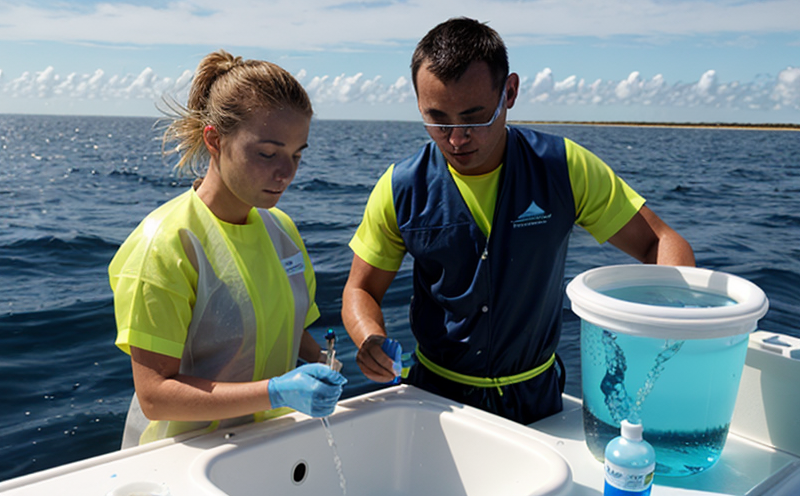ISO 16264 Polycyclic Aromatic Hydrocarbons PAH Test in Seawater
The ISO 16264 standard outlines a methodology for the determination of polycyclic aromatic hydrocarbons (PAHs) in seawater. PAHs are a group of organic compounds that can be found in various environmental matrices, including seawater, due to anthropogenic activities such as oil spills and industrial discharges. The presence of PAHs in the marine environment is of significant concern because these compounds can pose risks to aquatic life and human health.
The ISO 16264 test procedure involves several critical steps that ensure accurate and reliable results. Specimen preparation begins with the collection of seawater samples from predetermined locations, ensuring that the samples are representative of the area under investigation. Following collection, the samples undergo filtration to remove particulate matter and other debris, which can interfere with the analytical process.
The filtered water is then subjected to a series of extraction techniques depending on the PAHs being targeted. Common methods include liquid-liquid extraction (LLE) or solid-phase extraction (SPE), followed by derivatization for enhanced detection sensitivity using gas chromatography coupled with mass spectrometry (GC-MS). This approach allows for the precise quantification and identification of PAH compounds present in seawater.
The ISO 16264 protocol emphasizes the importance of standardizing sample preparation, extraction methods, derivatization processes, and instrumental settings to ensure consistency across different laboratories. This is crucial for meeting regulatory requirements and ensuring comparability of data from various sources. The acceptance criteria defined by this standard include detection limits, quantitation ranges, and precision standards that must be adhered to.
The significance of the ISO 16264 PAH test in seawater cannot be overstated. It plays a vital role in environmental monitoring programs aimed at assessing pollution levels in coastal waters. By providing accurate data on PAH concentrations, this testing method aids in making informed decisions regarding water quality management and remediation efforts.
Regulatory bodies such as the International Maritime Organization (IMO) and various national agencies often mandate compliance with ISO 16264 when conducting environmental assessments related to PAH contamination. Compliance ensures that industries responsible for discharging pollutants into marine environments can mitigate their impacts effectively.
Why It Matters
The presence of polycyclic aromatic hydrocarbons (PAHs) in seawater poses serious implications for both ecological and human health. PAHs are known carcinogens that accumulate in marine organisms, potentially leading to widespread contamination up the food chain. As these compounds bioaccumulate, they pose significant risks to fish populations and other aquatic life forms.
From a human perspective, consumption of contaminated seafood can lead to adverse health effects including cancer development. Therefore, ensuring compliance with standards like ISO 16264 becomes essential for protecting public health and maintaining sustainable marine ecosystems.
- Promotes Regulatory Compliance: Adherence to international standards ensures that your organization meets legal requirements set forth by governing bodies.
- Aids in Environmental Monitoring: Regular testing helps track changes over time, informing necessary corrective actions promptly.
- Enhances Reputation: Demonstrating commitment to environmental responsibility builds trust among stakeholders and consumers alike.
The ISO 16264 PAH test is particularly important for industries operating near coastlines or discharging effluents into marine environments. By adhering to this standard, these entities contribute towards preserving the health of our oceans while also safeguarding their own reputations and operations.
Benefits
- Precision: The ISO 16264 standard ensures precise measurement techniques are employed, leading to reliable test results.
- Consistency: Standardized procedures guarantee uniformity in testing across different laboratories worldwide.
- Regulatory Compliance: Meeting international standards helps organizations avoid penalties associated with non-compliance.
- Data Integrity: Accurate and consistent data enhances the credibility of reports submitted to regulatory authorities.
The use of this standard also brings about several indirect benefits such as improved water quality through proactive monitoring and management practices. Additionally, it fosters collaboration among stakeholders involved in environmental protection initiatives.
Environmental and Sustainability Contributions
- Reduction of PAH Pollution: By identifying sources of PAH pollution early on, corrective measures can be implemented to reduce their release into the environment.
- Conservation of Marine Ecosystems: Monitoring and mitigating PAH contamination helps protect marine biodiversity by preserving natural habitats.
- Hazardous Waste Management: Proper identification of pollutants enables effective waste disposal strategies that minimize harm to ecosystems.
- Enhanced Public Health: Minimizing human exposure to toxic compounds through stringent testing protocols supports public health initiatives.
The ISO 16264 PAH test contributes significantly to environmental sustainability by promoting responsible practices in industrial operations and fostering a healthier planet for future generations. Through rigorous adherence to this standard, organizations play an active role in safeguarding our oceans against contamination threats.





